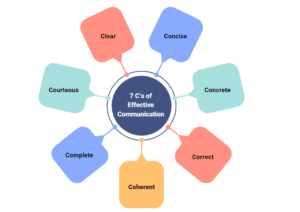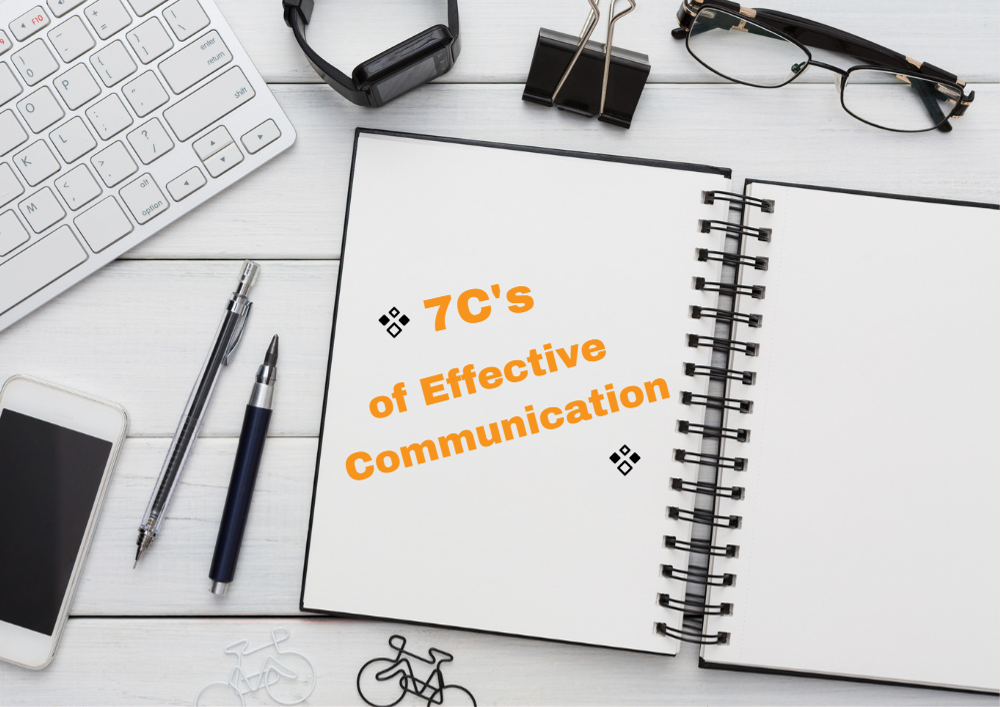Effective communication is essential for success in both personal and professional life. It serves as a powerful tool that allows us to express our ideas, thoughts, and feelings, fostering meaningful connections and building trust. Many factors influence effective communication, but seven key principles greatly contribute to its success. These principles are known as the 7 C’s and provide essential guidelines for achieving clear and impactful communication. Let’s explore the 7 C’s of Effective Communication in detail.
The 7 C’s of Effective Communication
- Clear
- Concise
- Concrete
- Correct
- Coherent
- Complete
- Courteous
1. Clear Communication – Eliminating Ambiguity for Effective Understanding
Clear communication is crucial for transmitting ideas and messages accurately. When your communication is clear, it leaves no room for misunderstanding or confusion. Consider the following tips for clear communication:
Tips:
- Use simple and understandable language: Avoid jargon or technical terms that may confuse your audience. Instead, use language that is easily comprehensible to ensure clarity.
- Provide specific and precise information: Clearly convey your message by providing specific details, facts, and examples that support your main points.
- Tailor your message to the audience: Consider the knowledge and background of your audience and adapt your communication style and language accordingly.
Example: When presenting a new project proposal to stakeholders, using clear language and providing specific details about the project’s objectives, benefits, and expected outcomes ensures that everyone understands the proposal’s key elements.
2. Concise Communication – Maximizing Impact with Minimal Words
Concise communication allows you to deliver your message efficiently, capturing the attention of your audience and preventing information overload. Consider the following tips for concise communication:
Tips:
- Focus on the main points: Identify the most important information and prioritize it in your communication. Avoid unnecessary details that may dilute your message.
- Use precise and impactful language: Choose words that convey your ideas concisely and leave a lasting impact on the listener or reader.
- Get to the point: Present your message in a direct manner, avoiding lengthy explanations or digressions.
Example: During a business presentation, using concise language and focusing on the key benefits and outcomes of a new product or service can quickly engage the audience and hold their attention.
3. Concrete Communication – Making Your Message Tangible and Realistic
Concrete communication involves providing specific and tangible examples to support your ideas. It helps your audience visualize concepts and understand them better. Consider the following tips for concrete communication:
Tips:
- Use vivid and descriptive language: Paint a clear picture with your words to help the listener or reader visualize your message.
- Provide real-life examples and case studies: Share specific instances or studies that demonstrate the practical application of your ideas.
- Appeal to the senses: Engage your audience by incorporating sensory details that make your message more relatable and memorable.
Example: When explaining the benefits of a healthy lifestyle, using concrete communication would involve describing real-life success stories of individuals who have improved their health through exercise and balanced nutrition.
4. Correct Communication – Ensuring Accuracy and Reliability
Correct communication is essential for building trust and credibility. It involves using accurate information and verifying facts before sharing them. Consider the following tips for correct communication:
Tips:
- Double-check your information: Verify the accuracy of the information you share, especially when presenting statistics, data, or technical details.
- Use reliable sources: Cite credible references, research studies, or expert opinions to support your statements and enhance the reliability of your message.
- Take responsibility for mistakes: If you make an error, acknowledge it promptly and correct it to maintain credibility.
Example: When discussing the impact of climate change, correct communication requires presenting scientifically validated data from reputable sources such as climate research institutions or international scientific reports.
5. Coherent Communication – Connecting Ideas for Seamless Understanding
Coherent communication ensures that your message flows smoothly and is easy to follow. It involves structuring your thoughts and ideas in a logical manner. Consider the following tips for coherent communication:
Tips:
- Organize your thoughts: Begin with a clear introduction that sets the context for your message. Present your main points in a logical order and provide transitions between ideas to create a cohesive flow.
- Use logical reasoning: Present arguments or ideas in a way that demonstrates a clear connection between them. Use supporting evidence and examples to strengthen your points.
- Summarize and reiterate key points: Periodically summarize your main points throughout the communication to reinforce understanding and help your audience follow along.
Example: When delivering a training workshop on project management, coherent communication involves presenting the stages of project planning, execution, and monitoring in a logical sequence. Each stage is supported by examples, case studies, and practical tips, ensuring that participants can easily grasp the overall process.
6. Complete Communication – Providing Comprehensive Information
Complete communication ensures that your message includes all the necessary information and leaves no gaps in understanding. Consider the following tips for complete communication:
Tips:
- Anticipate questions and address them proactively: Think about potential areas of confusion or points that may require further clarification. Address those questions preemptively in your communication.
- Provide additional resources or references: Offer supplementary materials, such as handouts, links, or recommended readings, to provide more in-depth information on the topic.
- Encourage feedback and questions: Create an open and interactive environment where your audience feels comfortable asking questions or seeking clarification.
Example: When delivering a product demonstration, complete communication involves providing comprehensive information about the product’s features, benefits, pricing, warranty, and customer support options. By addressing potential questions and offering additional resources, you ensure that customers have all the information they need to make informed decisions.
7. Courteous Communication – Respecting and Valuing Others
Courteous communication focuses on treating others with respect, empathy, and politeness. It fosters positive relationships and promotes effective collaboration. Consider the following tips for courteous communication:
Tips:
- Listen actively: Give your full attention to the speaker and demonstrate a genuine interest in their thoughts and perspectives.
- Use polite language and tone: Be mindful of maintaining a respectful and courteous tone in your communication, fostering a positive and inclusive environment. Consider cultural differences and choose words that are considerate and friendly.
- Show appreciation and gratitude: Acknowledge others’ contributions, ideas, or feedback, and express gratitude for their time and attention.
Example: In a team meeting, courteous communication involves actively listening to everyone’s input, using inclusive language, and acknowledging the contributions of team members. By showing respect and appreciation for different viewpoints, you create a positive and collaborative atmosphere that encourages open communication and idea-sharing.
Conclusion:
Mastering the 7 C’s of effective communication is a transformative skill that will benefit you in various aspects of your life. By incorporating these principles into your communication, you can convey your messages with clarity, engage your audience, and build stronger relationships. Practice these principles consistently, and you will witness positive changes in your relationships, both personal and professional. Remember, effective communication is a continuous journey of improvement, so keep refining your skills to unlock your full potential.
